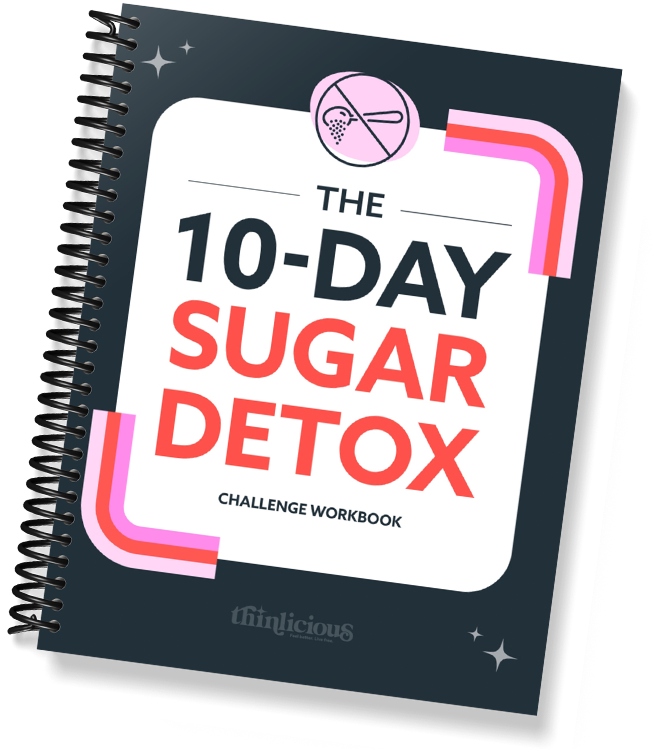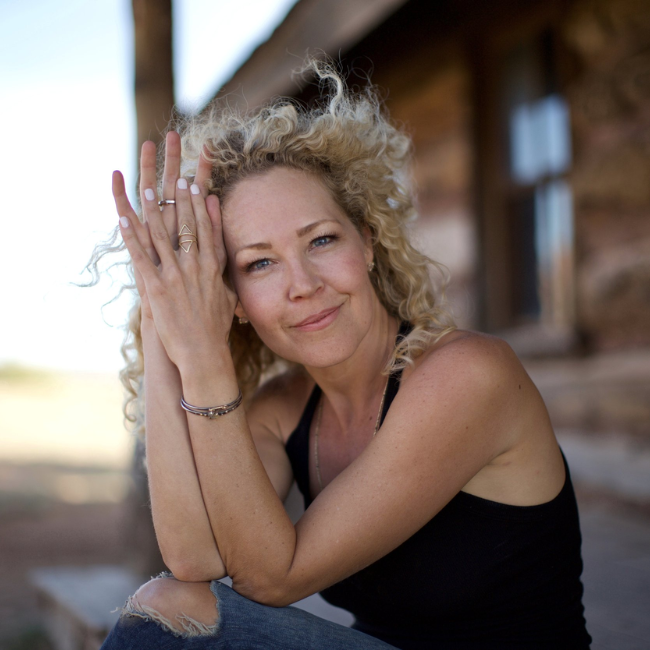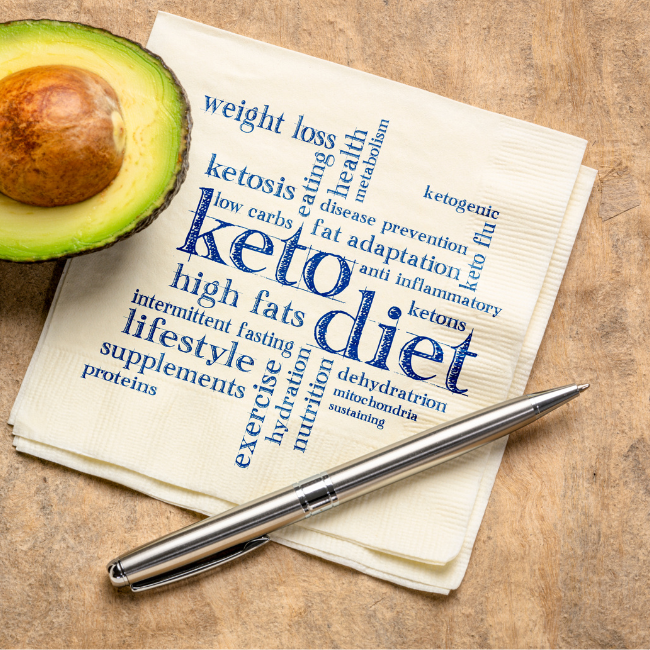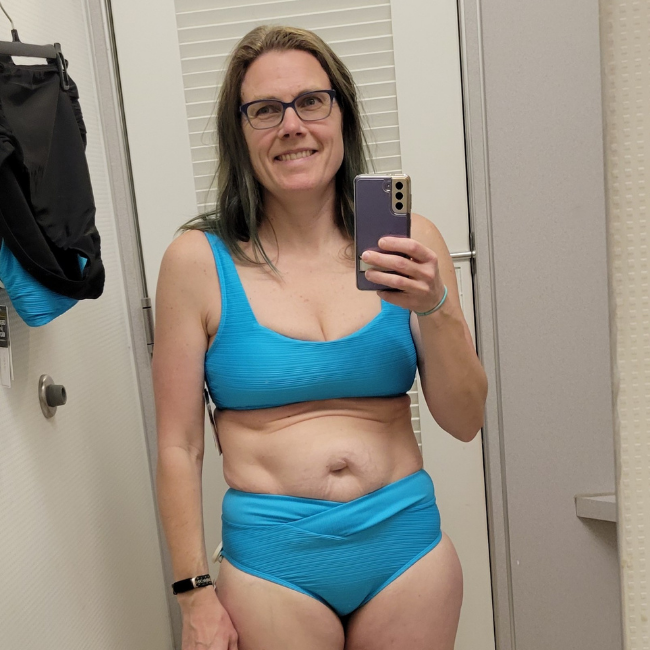You’re doing everything “right”—eating less, moving more, cutting calories—but that stubborn scale refuses to budge.
You spend your whole day thinking about food but trying not to eat it.
It used to be so easy.
You’d cut back for a few days and be right back in your skinny jeans.
Are you ready to lose weight and heal your body for life (without dieting, drugs, or making yourself miserable)?
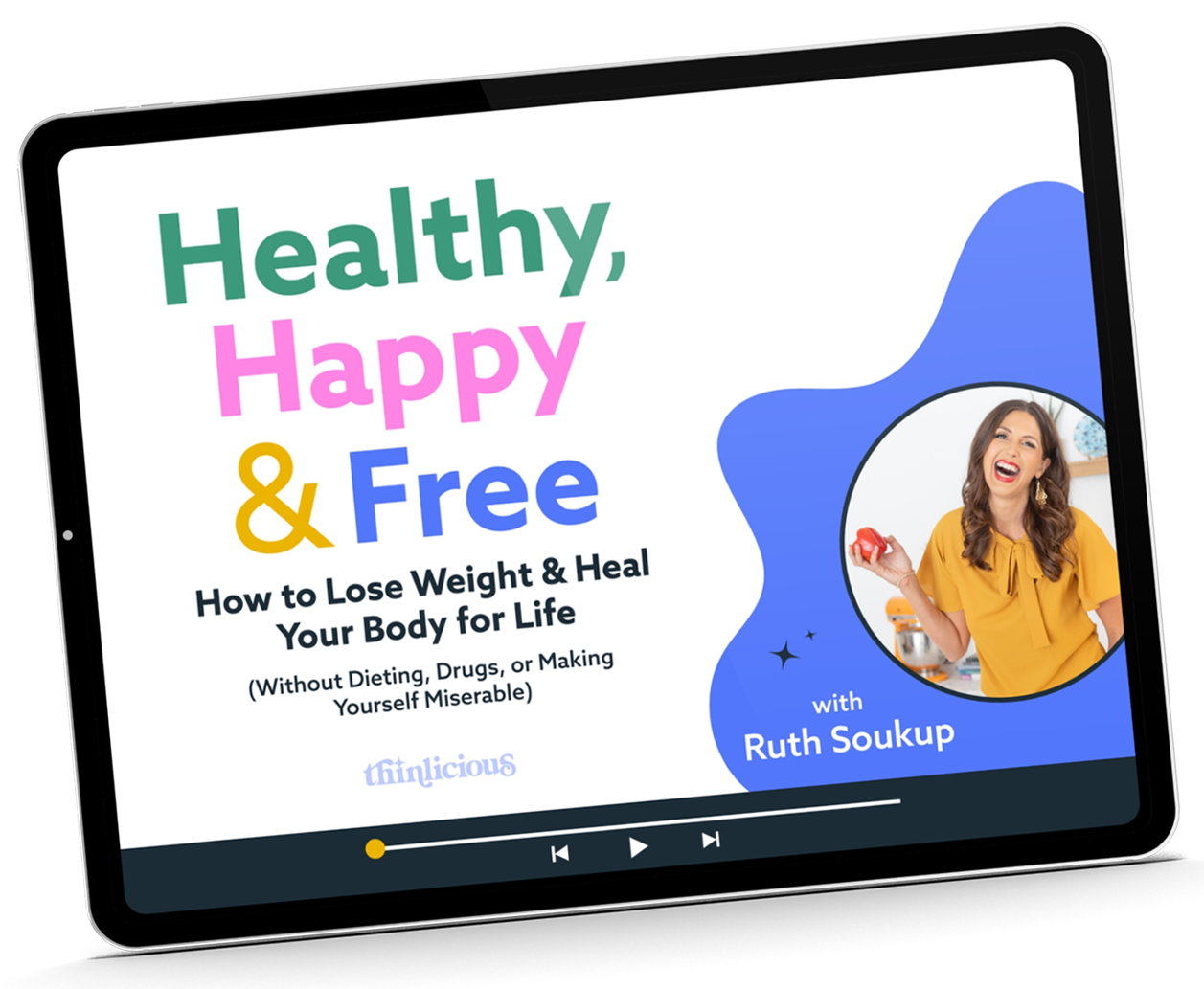
Our free on-demand video training will walk you through how to make this THE year you set health goals…and keep them.
But now it feels like your metabolism is just…broken.
And here’s the bad news: Your metabolism IS broken.
But there is some good news too.
It doesn’t have to be broken forever.
But it will mean taking a different approach. And that’s exactly what we’re going to talk about today.
Here’s what you should know about me: I’m a 47-year-old woman who struggled with my weight and health for a very long time, failing one diet after another, until I finally decided to take a radically different approach.
Instead of starting yet another diet, I started researching. And I quickly learned that almost everything we’ve ever been told about weight loss after 40 is completely wrong.
And that’s exactly the topic I want to dive into directly today—why losing weight after 40 feels like pushing a boulder uphill, and more importantly, what actually works when everything else has failed you.
Because I know I’m not the only woman out there who has struggled with this.
And what I also know is that if you’re over 40 and struggling to lose weight, you’re not weak, you’re not broken, and you don’t lack willpower.
You’re fighting against biology that’s been hijacked by decades of terrible advice.
And honestly, it gets me fired up just thinking about it, because I’ve been there.
I’ve lived that frustration for years, wondering what was wrong with me, why I couldn’t just stick to a stupid diet like everyone else seemed to be able to do.
But once you understand what’s really happening in your body—and how to work WITH it instead of against it—everything changes.
And we’re going to unpack all of it in a second, but before we dive in I did just want to say real quick that if you’re new here and want to understand exactly how I went from struggling for a decade to losing 49 pounds and keeping it off for years, that I’ve put together a free training that is SO helpful that will walk you through through creating your own personalized health plan.
You can grab it HERE.
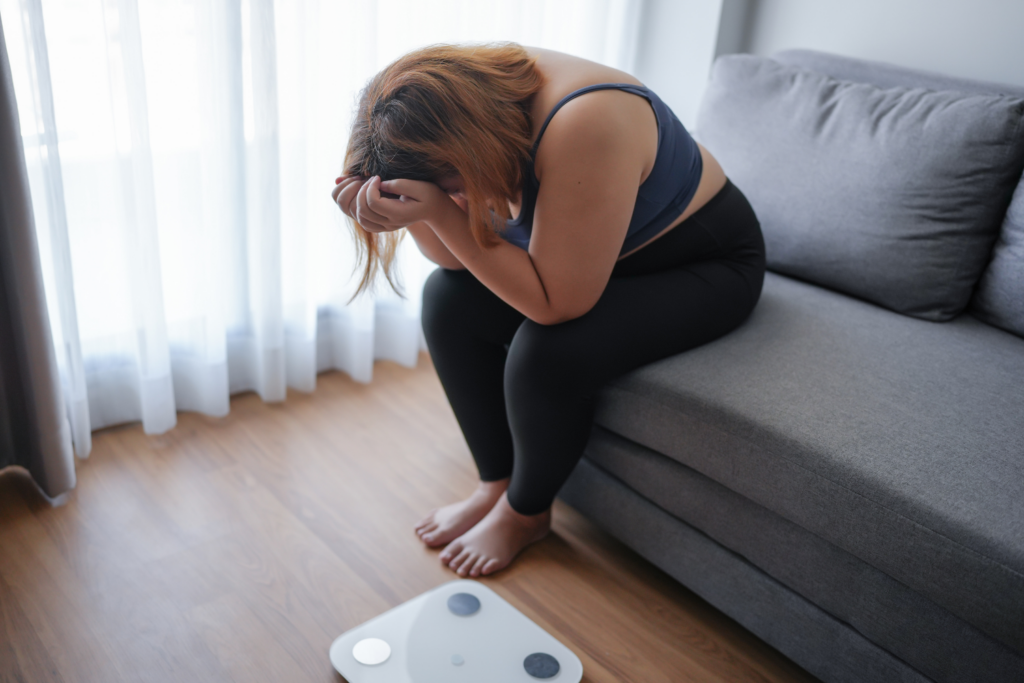
The Frustrating Reality: When Your Body Stops Cooperating
And with that out of the way, let’s dive in.
Because if you’re listening to this episode right now, you probably feel like your body has stopped cooperating with you altogether, right?
After all, you used to be able to skip dessert for a week and zip right back into your favorite jeans. Cut back for a few days after vacation, and boom—back to normal.
But now?
You’re doing everything you’ve always done, maybe even more, and that number on the scale is either stuck or creeping up.
Those jeans in your closet are taunting you. And every day feels like a battle you’re losing.
You’re eating salads for lunch while your coworkers demolish pizza.
You’re dragging yourself to spin class at 6 AM when you’d rather be sleeping. You’re counting every calorie, weighing every portion, drinking so much water you practically live in the bathroom.
All the things the experts tell you to do.
All the things that used to work.
But your body seems to have other plans.
And the worst part?
Everyone around you is either struggling with the same thing or offering the same old advice that makes you want to scream.
Or you’re seeing a million different influencers on Instagram, telling you that it’s your hormones or your cortisol, or that you just need to go on Ozempic and everything will be okay. Don’t eat carbs. Do eat carbs. Get more protein.
It’s enough to make your head spin.
But what’s not always being fully explained or accounted for is the fact that your body at 45 or 55 is not the same as your body at 25.
The rules have changed, and nobody bothered to give you the new playbook.
In fact, a lot of the advice you’re still getting—especially from the eat less, exercise more crowd—is not just ineffective for women over 40, it’s actually counterproductive. It’s making the problem worse.
And that’s not your fault. You’ve been lied to. We all have.
The Triple Threat: What’s Really Working Against You
So what’s actually happening here?
Why does it feel like your metabolism just decided to take a permanent vacation?
Well, the truth is that it’s not one thing—it’s a perfect storm of biological changes that hit women after 40.
And the real kicker is that most doctors don’t even talk about this stuff.
They’ll tell you to eat less and exercise more, maybe run some basic blood work, and when that doesn’t work, they’ll shrug and say, “Well, this is just what happens as we age.”
That’s crap. And I’m going to tell you exactly why.
The Hormone Hurricane
First up: hormones.
And I’m not just talking about hot flashes and mood swings, though those are super fun too.
Starting in your late 30s and early 40s, your estrogen and progesterone levels begin their descent.
And while most people think of estrogen as just a reproductive hormone, it’s so much more than that.
Estrogen helps regulate where your body stores fat and how efficiently you burn it.
It also affects your insulin sensitivity—how well your cells respond to insulin.
That means that when your estrogen drops, your body starts hoarding fat like it’s preparing for winter—especially around your middle.
Ever notice how you can eat the exact same way you always have, but suddenly you’re gaining weight in places you never did before? That’s your dropping estrogen at work.
Progesterone, meanwhile, helps regulate your metabolism and reduces water retention.
It’s also a natural anti-anxiety hormone—it helps you feel calm and sleep well. As it declines, you might notice you’re puffier, more bloated, your metabolism feels sluggish, and you’re more anxious or having trouble sleeping.
And poor sleep?
That messes with two other crucial hormones: leptin and ghrelin.
Leptin tells your brain you’re full, while ghrelin tells you you’re hungry. When you don’t sleep well, leptin drops and ghrelin spikes. Translation: you feel hungry all the time and never feel satisfied when you eat.
An as if all that weren’t fun enough, while these helpful hormones are dropping, your cortisol–aka your stress hormone–often goes up.
Hello, sandwich generation stress, career pressure, and the delightful combination of teenagers and aging parents. Yep, midlife is awesome.
But high cortisol is like yet another fat-storage signal to your body. It’s literally telling your cells, “Hold onto everything, we’re in crisis mode.”
It also makes you crave sugar and refined carbs because your body thinks it needs quick energy to deal with whatever emergency it thinks you’re facing.
So you’re hungrier, you’re craving junk food, you’re storing fat more efficiently, and you’re not sleeping well.
So it doesn’t just feel like your body is actively working against your weight loss efforts.
It actually is.
But hormones are only one piece of the puzzle.
The Muscle Mass Mystery
The second piece of the puzzle is muscle loss.
Starting around age 30, we start losing between 3 and 8% of our muscle mass per decade.
If you’re sedentary, it can be even more.
Now, you might think, “So what? I don’t want to be bulky anyway.”
But here’s what you need to understand: muscle is metabolically expensive.
It burns calories just sitting there, even when you’re sleeping.
Every pound of muscle burns about 6-7 calories per day at rest, while fat burns about 2-3 calories per day.
So every pound of muscle you lose is like losing a little calorie-burning furnace.
Your metabolism slows down not because you’re older, but because you have less metabolically active tissue.
And if you’ve been doing what most women do—endless cardio and eating less—you’re actually accelerating muscle loss. When you restrict calories severely and do hours of cardio, your body breaks down muscle for energy.
This is like putting your metabolism in reverse.
I see this all the time with women who come to me after months of eating 1,200 calories a day and doing cardio six days a week. They’re exhausted, they’re not losing weight, and they’ve actually made their metabolism slower than when they started.
It’s heartbreaking, because they’re working so hard and getting the opposite of what they want.
And just so you know, Ozempic and other similar GLP-1 drugs make you lose a ton of muscle as well. In fact, to me, that’s what makes them so dangerous, beyond even the other more well-known side effects that people talk about.
Losing muscle mass is literally the worst thing you can possibly do for both your current metabolic issues and your future health.
So that’s the second piece you need to understand.
The Insulin Resistance Reality
But the third piece that’s often being ignored, and what I didn’t learn until I started doing my own research is that the biggest factor affecting your ability to lose weight after 40 isn’t your age—it’s insulin resistance.
Studies show that up to 88% of American adults have some degree of metabolic dysfunction, which is just a fancy way of saying your body can’t handle carbohydrates and sugar the way it used to.
Here’s how insulin resistance develops:
Every time you eat carbs or sugar, your blood sugar rises. Your pancreas releases insulin to shuttle that sugar into your cells for energy. But when this happens repeatedly—like when you eat the Standard American Diet loaded with refined carbs and sugar—your cells start to resist insulin’s signal.
It’s like someone knocking on your door over and over. Eventually, you stop answering. Your cells do the same thing with insulin. So your pancreas makes more insulin, trying to force the sugar into your cells. More insulin means more fat storage.
When you’re insulin resistant, your body is essentially stuck in fat-storage mode. It doesn’t matter how few calories you eat—if your insulin levels are high, your body can’t access stored fat for energy.
It’s like having a full gas tank but a broken fuel line. The energy is there, but your body can’t use it.
So you feel tired, hungry, and your body keeps storing more fat even when you’re eating less.
And here’s the really frustrating part: insulin resistance gets worse with age, especially for women going through perimenopause and menopause.
Insulin is also a hormone, and because all your hormones are part of the same interconnected endocrine system, the hormonal changes we talked about earlier make insulin resistance worse, which makes weight gain easier and weight loss harder.
So that’s what I mean by a perfect storm–you’ve got hormones, muscle loss, and insulin resistance all working against you to basically shut down your metabolism, and it’s all coming to a head right as you reach your forties.
But you’re still trying to diet like you’re 25.
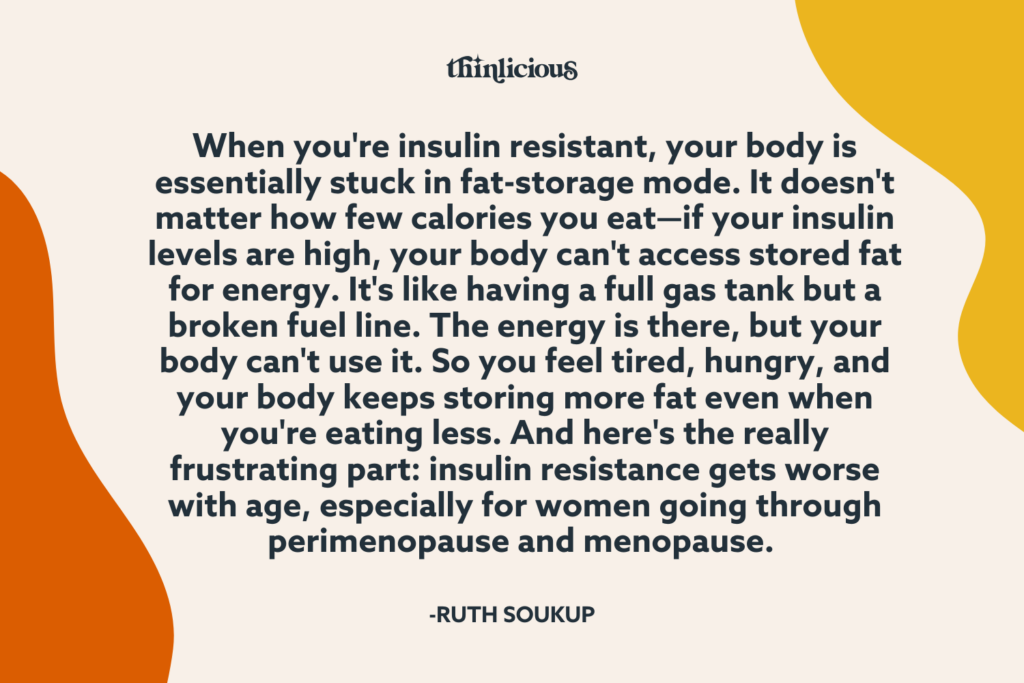
The Diet Industry Lie That’s Keeping You Stuck
And this brings me to the biggest lie you’ve been sold about weight loss after 40:
that it’s still about calories in, calories out.
I cannot tell you how many women come to my TAS program after months or years of eating 1,200 calories a day, feeling hungry and miserable, only to watch the scale refuse to budge.
That was definitely the case for Michelle.
She came to me after two years of tracking every bite, weighing her food, eating tiny portions. She was doing everything “right” according to conventional wisdom. She was eating about 1,100 calories a day and working out six times a week.
And she hadn’t lost a single pound in eight months.
Her doctor told her she needed to eat even less and exercise more.
Can you imagine? This woman was already eating like a bird and exercising like a maniac, and the medical advice was to do more of what wasn’t working.
Michelle thought she was broken.
She thought she lacked willpower.
She was convinced she was just destined to be overweight forever.
But here’s what was really happening: Sarah’s metabolism had slowed down to match her calorie intake. Her thyroid hormones had dropped. Her cortisol was sky-high from the stress of constant restriction and over-exercising. Her body was in full-on starvation mode, clinging to every calorie and storing fat whenever possible.
She wasn’t weak. She just was following advice that was guaranteed to fail.
When you severely restrict calories, especially as a woman over 40, your body goes into survival mode.
Your metabolism slows down, your hunger hormones go haywire, and your body becomes even more efficient at storing fat.
It’s an evolutionary adaptation that kept our ancestors alive during famines. But in our modern world, where food is abundant but we’re constantly dieting, it’s keeping us fat and frustrated.
This is why 95% of diets fail. It’s why you can “be good” all week and still not lose weight. It’s why that voice in your head keeps whispering that you’re just not trying hard enough.
You are trying hard enough. You’re just using the wrong approach.
What Actually Works: The Science-Based Solution
So if diets don’t work, and willpower isn’t the answer, what is?
The solution is fixing your metabolism by addressing the root cause: hormonal imbalance, but specifically insulin resistance.
When you stabilize your blood sugar and lower your insulin levels, your body can finally access stored fat for energy.
You become what we call “metabolically flexible”—able to burn both fat and carbs efficiently, instead of being stuck burning only sugar.
This isn’t about another restrictive diet. It’s about retraining your metabolism to work the way it’s supposed to.
The Real Enemy: Sugar and Processed Carbs
So what are the foods that spike your insulin the most?
Sugar and refined carbohydrates. These include obvious culprits like candy and soda, but also “healthy” foods like whole grain bread, oatmeal, fruit smoothies, and fat-free yogurt.
And let me be clear about something: the food industry has done an incredible job of convincing us that processed junk is healthy.
Low-fat yogurt with fruit on the bottom? That’s basically dessert with a health halo. Whole grain cereal? Sugar with some fiber sprinkled in.
I was the queen of “healthy” processed foods during my vegetarian years.
I ate granola for breakfast thinking it was nutritious. I made green smoothies with banana, mango, and dates, convinced I was doing something good for my body. I snacked on energy bars that had 20+ grams of sugar but were marketed as “natural” and “clean.”
Meanwhile, I was gaining weight and feeling terrible, wondering why my supposedly healthy diet wasn’t working.
When you eat these foods, your blood sugar spikes, your pancreas pumps out insulin, and your body gets the signal to store fat.
If this happens repeatedly—which it does when you eat the Standard American Diet—your cells become resistant to insulin.
And here’s something that’ll blow your mind: artificial sweeteners can be just as bad.
Sucralose, aspartame, saccharin—these chemical sweeteners can spike insulin just like regular sugar. That diet soda you think is helping?
It might be making things worse.
The Power of Real Food
So what are foods that keep your insulin stable?
Real, whole foods that our great-grandmothers would recognize. Meat, fish, eggs, vegetables, healthy fats like avocado and olive oil.
These foods don’t spike your blood sugar. They keep insulin low, which allows your body to access stored fat for energy. They’re also incredibly satiating—you feel full and satisfied without obsessing over portions.
When I finally made the switch from processed “health” foods to real food, everything changed.
I could eat until I was full and still lose weight. I wasn’t thinking about food every five minutes. My energy was steady throughout the day instead of the constant ups and downs I’d experienced for years.
And here’s the beautiful part: real food tastes amazing.
Butter, cream, avocado, steak—these aren’t diet foods, they’re delicious foods that happen to support your metabolism instead of sabotaging it.
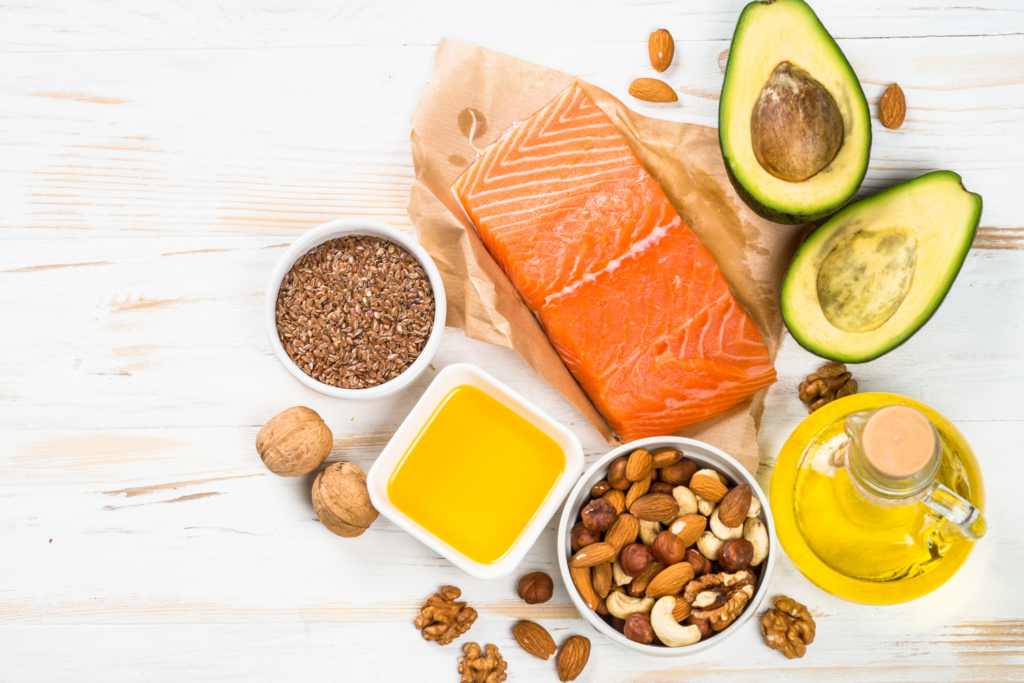
Why Protein Is Your Secret Weapon
One of the biggest mistakes I see women over 40 make is not eating enough protein.
We’ve been so brainwashed by the low-fat mentality that we’re afraid of foods that actually help us.
But protein not only helps preserve that precious muscle mass we talked about earlier, it also has the highest thermic effect of all macronutrients. That means your body actually burns calories digesting protein—up to 30% of the calories in protein are burned just processing it.
Protein also keeps you full longer than any other nutrient and helps stabilize blood sugar. When you eat protein with any carbs you do consume, it blunts the insulin response.
After 28 years as a vegetarian, adding protein back into my diet was the key that unlocked my weight loss.
I’d been getting maybe 40-50 grams of protein a day, thinking beans and quinoa were adequate. But when I started aiming for 100+ grams of high-quality animal protein daily, everything shifted.
Within months of prioritizing protein, I broke through a plateau that had lasted weeks and lost the final 15 pounds to reach my goal.
My body composition changed dramatically—I was building muscle while losing fat, something that had never happened during my low-protein vegetarian years.
The Metabolic Flexibility Factor
And here’s what I want you to understand about becoming metabolically flexible: it’s not just about losing weight.
It’s about completely transforming how your body functions.
When your metabolism is working properly, your body can seamlessly switch between burning glucose and burning fat for fuel. This is how we’re designed to function. Our ancestors didn’t have constant access to food, so our bodies evolved to be incredibly efficient at using whatever fuel was available.
But the modern diet—high in processed carbs and sugar, eaten frequently throughout the day—has broken this system for most of us. We’re stuck burning only glucose, which means we’re constantly hungry and always storing fat.
When you become metabolically flexible again, amazing things happen:
Your energy becomes steady throughout the day instead of riding the blood sugar roller coaster. You can go hours without eating and feel fine.
Your cravings for junk food virtually disappear. Your mood stabilizes because your brain has a consistent fuel source. And yes, weight loss becomes effortless because your body can finally access stored fat.
This is what I mean when I say it’s not about willpower—it’s about biology.
Fix the biology, and the behaviors follow naturally.
The Real-World Challenge: Why Information Isn’t Enough
And here’s what I’ve learned after helping thousands of women transform their health: knowing what to do and actually doing it consistently are two very different things.
You can read all the books, listen to all the podcasts, understand the science perfectly—but if you don’t have a proven system and ongoing support, you’ll likely end up back where you started.
I see this happen all the time. Someone learns about insulin resistance, gets excited about the science, tries to go low-carb on their own, and then gets overwhelmed or confused and gives up.
Or they do well for a few weeks, hit a plateau, don’t know how to adjust, and assume it’s not working for them.
Or they succeed at losing weight but don’t know how to transition to maintenance, so they either keep restricting and get burnt out, or they go back to old habits and regain the weight.
This is why 95% of people who try to lose weight on their own fail to keep it off long-term. It’s not because they lack willpower—it’s because they lack a system.
Why Systems Beat Willpower Every Time
Here’s the thing about willpower and even good intentions—it’s finite. You can white-knuckle your way through a few weeks, maybe even a few months.
But eventually, life happens. Stress hits. You get tired. Your willpower crumbles and all your good intentions go out the window.
But systems? Systems are sustainable.
They take the guesswork out of what to eat, when to eat, and how to navigate the inevitable challenges that come up.
That’s why I created the Thin Adapted System, otherwise known as TAS.
In TAS, we don’t just tell you to “eat low carb.” We guide you through four distinct phases, each with specific goals and timelines.
We show you exactly how to transition from being a sugar-burner to a fat-burner, step by step.
Phase Zero is all about preparation—getting your mind right, stocking your kitchen, planning for success before you even start changing what you eat.
Phase One is the metabolic reset—the first 4-6 weeks where we’re retraining your body to burn fat instead of sugar. This is where the magic happens, but it’s also where people need the most support because your body is going through a significant transition.
Phase Two is active weight loss—where your body is efficiently burning fat and the pounds are coming off. This phase can last anywhere from a few weeks to several months, depending on how much weight you want to lose.
And Phase Three is metabolic flexibility—the maintenance phase where you have the freedom to enjoy a wider variety of foods while maintaining your weight loss and energy levels.
Each phase has specific macro targets, meal plans, exercise recommendations, and mindset work. You’re never wondering what to do next or whether you’re doing it right.
The Power of Expert Guidance
One of the things I’m most proud of about TAS is our team of certified coaches. These aren’t just people who read a book about nutrition—they’re women who have been through the program themselves and then completed extensive training to help others succeed.
When you hit a plateau, they know exactly how to help you break through. When you’re struggling with cravings, they have strategies that actually work. When life gets chaotic and you’re tempted to give up, they’re there to help you stay on track.
Our head coach, Lisa, came to the program after years of yo-yo dieting. She was a successful businesswoman who felt like she could manage everything in her life except her weight. Sound familiar?
Through TAS, she not only lost 45 pounds and kept it off, but she discovered a passion for helping other women do the same. She went through our certification program and now leads our coaching team.
Lisa always says, “I’m not just teaching you what worked for me—I’m teaching you what works, period. The science doesn’t lie.”
And that’s the beautiful thing about having coaches who’ve walked this path. They understand the emotional challenges, the practical obstacles, the moments of doubt. They’ve been there, and they know how to guide you through it.
The Power of Community and Accountability
One of the most powerful aspects of TAS is the community. When you’re surrounded by women who understand your struggles, who celebrate your wins, and who can offer support when you’re having a tough day, everything changes.
Our TAS Facebook group is filled with women sharing victories, asking questions, and supporting each other through challenges. There’s something magical about not feeling alone in this journey.
As one of our members once said, “I used to think I was the only one who could gain weight by looking at a cookie. Finding this group and realizing that thousands of other smart, successful women have struggled with the exact same things has been life-changing. I don’t feel broken anymore.”
That’s the power of community. When you realize you’re not the only one who’s struggled, when you see other women succeeding with the same challenges you face, it shifts everything.
Our members share meal ideas, troubleshoot problems together, and celebrate non-scale victories like having more energy, sleeping better, or finally getting off blood pressure medication.
Plus, our certified coaches are active in the group every day, answering questions, providing guidance, and offering encouragement. It’s like having a team of experts in your back pocket.

Real Results That Last
The women in our program don’t just lose weight—they transform their relationship with food, their energy levels, and their confidence. They go from feeling defeated and stuck to feeling empowered and in control.
Let me tell you about Janet, who joined TAS at age 52 after struggling with her weight for over a decade. She’d tried every diet imaginable—Weight Watchers, Noom, keto on her own, intermittent fasting, you name it.
Janet lost some weight on each of these approaches, but she always gained it back. She was convinced she was just destined to be overweight and had started to accept that this was just her reality.
When she started TAS, she was skeptical. “I’ve heard all this before,” she told me. “What makes this different?”
What made it different was the comprehensive approach. It wasn’t just about food—it was about mindset, support, and having a clear plan for every phase of the journey.
In her first month, Janet lost 12 pounds. But more importantly, she felt better than she had in years. Her energy was stable, her cravings were gone, and she was sleeping through the night for the first time in months.
By month six, she’d lost 48 pounds and completely transformed her health markers. Her A1C went from pre-diabetic to normal. Her blood pressure normalized. Her doctor was amazed.
But here’s the best part: two years later, Janet has maintained her weight loss and continues to feel amazing. She’s not white-knuckling it or fighting cravings. This is just how she lives now.
And that’s what I mean when I say this isn’t a diet—it’s a lifestyle transformation.
More importantly, they keep the weight off. Because when you address the root cause—insulin resistance and metabolic dysfunction—instead of just restricting calories, the changes stick.
The Path Forward: Your Next Step
Look, I get it. You’ve probably tried so many things that worked for a while and then stopped working. You might be skeptical that anything can help at this point.
I felt the same way when I hit 201 pounds at age 43. I’d failed at so many diets that I genuinely believed I was just destined to be overweight forever.
I remember looking at that photo my neighbor posted on Facebook—the one where I looked heavier than I’d ever looked in my life—and thinking, “Maybe this is just who I am now. Maybe I need to accept this and buy bigger clothes.”
But something in me refused to give up. Maybe it was stubbornness, maybe it was desperation, but I decided to give it one more shot. Not another diet, but a completely different approach.
And changing my approach—focusing on hormones instead of calories, healing instead of restricting—changed everything. Four years later, I’m 49 pounds lighter and have more energy than I had in my 30s.
But more than that, I have freedom. Freedom from obsessing about food, freedom from shame about my body, freedom from the constant cycle of restrict-and-binge that dominated my life for so long.
And here’s what I want you to understand: you’re not too old, it’s not too late, and you’re definitely not too broken to fix this.
Your body wants to be healthy. It wants to burn fat efficiently, regulate hormones properly, and give you sustained energy. You just need to give it the right conditions to do what it’s designed to do.
The Science Is Clear
The research on insulin resistance, metabolic dysfunction, and hormonal changes in women over 40 is overwhelming. We know what’s causing the problem, and we know how to fix it.
A 2019 study published in the Journal of Clinical Medicine found that women who followed a low-carb approach lost significantly more weight and improved their metabolic markers compared to those following a low-fat diet.
Another study in the American Journal of Clinical Nutrition showed that protein intake becomes even more critical for women over 40 to preserve muscle mass and maintain metabolic rate.
And research published in Diabetes Care demonstrated that addressing insulin resistance through dietary changes is more effective than calorie restriction alone for sustainable weight loss in postmenopausal women.
The science isn’t debatable anymore. What’s been debatable is how to implement these findings in a sustainable, realistic way for busy women juggling careers, families, and everything else life throws at us.
That’s where TAS comes in.
Ready to Stop Fighting Your Biology?
If you’re tired of fighting against your body and ready to work with it instead, the Thin Adapted System is your roadmap. It’s not another diet—it’s a complete lifestyle transformation with the science, support, and step-by-step guidance you need to succeed.
We’ve helped thousands of women over 40 not just lose weight, but completely transform their health and their lives. Women who thought they were broken, who’d given up hope, who believed their best days were behind them.
And we can help you too.
To learn more about TAS and see if it’s right for you, check out that free training I told you about earlier–it’s linked in the show notes. I’ll walk you through exactly how the program works, share success stories from women just like you, and show you how it can help you finally break free from the cycle of failed diets and reclaim your health.
Final Thoughts
Before we wrap up, I want you to remember this: struggling to lose weight after 40 isn’t a character flaw or a sign of weakness. It’s biology. It’s hormones. It’s decades of following advice that was never going to work for your changing body.
The deck has been stacked against you from the start. The food industry has filled our grocery stores with processed junk disguised as health food. The medical establishment has clung to outdated advice that ignores hormonal changes. The fitness industry has convinced us that more is always better, even when it’s making us worse.
But now you know better. You understand that it’s not about eating less—it’s about eating right. It’s not about more willpower—it’s about better strategy. It’s not about fighting your body—it’s about healing it.
You have the power to change this story. To go from feeling defeated and stuck to feeling vibrant and confident. To stop letting your weight hold you back from living the life you want.
Your metabolism isn’t broken forever. Your best days aren’t behind you. And you’re definitely not too old to transform your health.
But it requires a different approach than what you’ve been taught. It requires understanding your body’s biology instead of fighting against it. It requires support and guidance instead of trying to figure it out alone.
And most importantly, it requires believing that you’re worth the effort. Because you are.
The woman you’re meant to be—energetic, confident, healthy, free—she’s still there. She’s been waiting for you to stop fighting yourself and start healing yourself.
Today can be the day you stop settling for feeling stuck and start creating the vibrant, healthy life you deserve
What if you could actually take control of
your health in just 10 days?
It’s not your fault you can’t lose weight as a woman over 40 even though you’ve likely tried literally everything. Your metabolism probably feels broken and your hormones are likely all out of whack.
But you can fix it all with ONE simple change: eliminate sugar. We make it super easy with daily lessons teaching you the science behind what makes us gain weight in our midlife and beyond! Are you ready to get started now?

